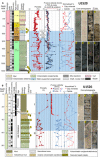Slow slip source characterized by lithological and geometric heterogeneity
- PMID: 32232148
- PMCID: PMC7096157
- DOI: 10.1126/sciadv.aay3314
Slow slip source characterized by lithological and geometric heterogeneity
Abstract
Slow slip events (SSEs) accommodate a significant proportion of tectonic plate motion at subduction zones, yet little is known about the faults that actually host them. The shallow depth (<2 km) of well-documented SSEs at the Hikurangi subduction zone offshore New Zealand offers a unique opportunity to link geophysical imaging of the subduction zone with direct access to incoming material that represents the megathrust fault rocks hosting slow slip. Two recent International Ocean Discovery Program Expeditions sampled this incoming material before it is entrained immediately down-dip along the shallow plate interface. Drilling results, tied to regional seismic reflection images, reveal heterogeneous lithologies with highly variable physical properties entering the SSE source region. These observations suggest that SSEs and associated slow earthquake phenomena are promoted by lithological, mechanical, and frictional heterogeneity within the fault zone, enhanced by geometric complexity associated with subduction of rough crust.
Copyright © 2020 The Authors, some rights reserved; exclusive licensee American Association for the Advancement of Science. No claim to original U.S. Government Works. Distributed under a Creative Commons Attribution NonCommercial License 4.0 (CC BY-NC).
Figures





References
-
- Liu Y., Rice J. R., Spontaneous and triggered aseismic deformation transients in a subduction fault model. J. Geophys. Res. 112, (2007).
-
- Skarbek R. M., Rempel A. W., Schmidt D. A., Geologic heterogeneity can produce aseismic slip transients. Geophys. Res. Lett. 39, (2012).
-
- Saffer D. M., Wallace L. M., The frictional, hydrologic, metamorphic and thermal habitat of shallow slow earthquakes. Nat. Geosci. 8, 594–600 (2015).
-
- Kodaira S., Iidaka T., Kato A., Park J.-O., Iwasaki T., Kaneda Y., High pore fluid pressure may cause silent slip in the Nankai trough. Science 304, 1295–1298 (2004). - PubMed
-
- Bell R., Sutherland R., Barker D. H. N., Henrys S., Bannister S., Wallace L. M., Beavan J., Seismic reflection character of the Hikurangi subduction interface, New Zealand, in the region of repeated Gisborne slow slip events. Geophys. J. Int. 180, 34–48 (2010).
LinkOut - more resources
Full Text Sources

